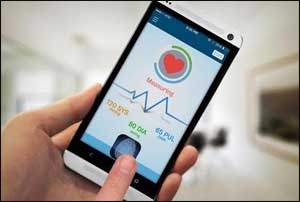- Home
- Editorial
- News
- Practice Guidelines
- Anesthesiology Guidelines
- Cancer Guidelines
- Cardiac Sciences Guidelines
- Critical Care Guidelines
- Dentistry Guidelines
- Dermatology Guidelines
- Diabetes and Endo Guidelines
- Diagnostics Guidelines
- ENT Guidelines
- Featured Practice Guidelines
- Gastroenterology Guidelines
- Geriatrics Guidelines
- Medicine Guidelines
- Nephrology Guidelines
- Neurosciences Guidelines
- Obs and Gynae Guidelines
- Ophthalmology Guidelines
- Orthopaedics Guidelines
- Paediatrics Guidelines
- Psychiatry Guidelines
- Pulmonology Guidelines
- Radiology Guidelines
- Surgery Guidelines
- Urology Guidelines
Blood Pressure with your fingertip with new smartphone device

The Standard procedure of blood pressure measurement is by using a blood pressure apparatus with inflatable arm cuff to vary the pressure applied to the brachial artery.Chandrasekhar from Department of Electrical and Computer Engineering at Michigan State University in East Lansing and colleagues have invented a special new device, using high-tech 3-D printing, that contains an embedded optical sensor on top of a "force" sensor.The user provides external pressure on an artery in the finger by pressing an optical sensor overlaying a force transducer on the back of a modified smartphone.The phone runs an app to ensure that the user maintains sufficient finger contact while computing brachial artery blood pressures from the finger-based measurements.That information is then fed to a smartphone app that converts the data to a real-time blood pressure reading, displayed on the phone, says a team led by Ramakrishna Mukkamala of Michigan State University.The paper has been published in Science Translational Medicine.
The authors have extended the oscillometric principle used by most automatic cuff devices, to develop a cuff-less BP monitoring device using a smartphone which will help make measuring blood pressure more accessible.There are a number of cuffless technologies which are being developed, but so far, many developing solutions have problems with either convenience or accuracy.The new device can independently measure systolic and diastolic blood pressure without calibration. A smartphone application provides visual feedback to guide the amount of pressure applied over time via the finger pressing and computes systolic and diastolic BP from the measurements showed that blood pressure readings were similar using their smartphone device, a standard arm cuff device, and a finger-cuff device in a group of participants.
Some of the expert feel that the work is promising and is significantly different because it takes the smartphone BP reading technology a step further with an attachment. However, he cautions against drawing firm conclusions from the work and urges a formalized validation study.
According to the paper, the device yielded bias and precision errors of 3.3 and 8.8 mm Hg, respectively, for systolic BP over a 40 to 50 mm Hg range of blood pressure. The bias and precision errors were −5.6 and 7.7 mm Hg for diastolic BP.The new device offers fair accuracy with convenience but the limitations are that the device can't take nighttime readings and may not be usable for people who lack fine motor skills.The user presses a finger against the sensor to steadily increase pressure on the artery just as a cuff presses the artery against the bone. After enough finger pressure is applied, the measurement ends and the device displays a reading. If there are problems with the reading, it asks the user to try again.
For further reference log on to: DOI: 10.1126/scitranslmed.aap8674

Disclaimer: This site is primarily intended for healthcare professionals. Any content/information on this website does not replace the advice of medical and/or health professionals and should not be construed as medical/diagnostic advice/endorsement or prescription. Use of this site is subject to our terms of use, privacy policy, advertisement policy. © 2020 Minerva Medical Treatment Pvt Ltd